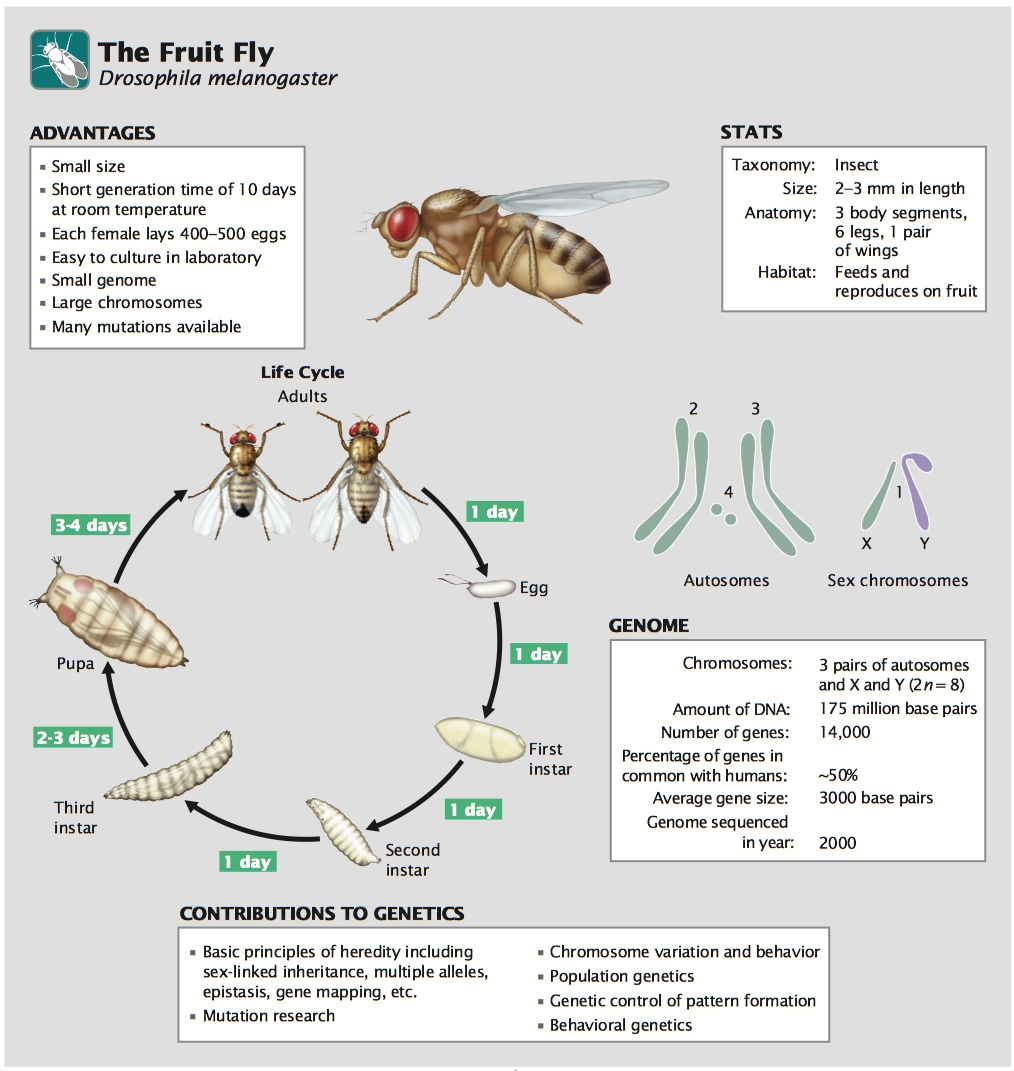The Fruit Fly Drosophila melanogaster
Drosophila melanogaster, a fruit fly, was among the first organisms used for genetic analysis and, today, it is one of the most widely used and best known genetically of all organisms. It has played an important role in studies of linkage, epistasis, chromosome genetics, development, behavior, and evolution. Because all organisms use a common genetic system, understanding a process such as replication or transcription in fruit flies helps us to understand these same processes in humans and other eukaryotes.
Drosophila is a genus of more than 1000 described species of small flies (about 1 to 2 mm in length) that frequently feed and reproduce on fruit, although they rarely cause damage and are not considered economic pests. The best known and most widely studied of the fruit flies is D. melanogaster, but genetic studies have been extended to many other species of the genus as well. D. melanogaster first began to appear in biological laboratories about 1900. After first taking up breeding experiments with mice and rats, Thomas Hunt Morgan began using fruit flies in experimental studies of heredity at Columbia University. Morgan’s laboratory, located on the top floor of Schermerhorn Hall, became known as the Fly Room (see Figure 4.11b). To say that the Fly Room was unimpressive is an understatement. The cramped room, only about 16 by 23 feet, was filled with eight desks, each occupied by a student and his experiments. The primitive laboratory equipment consisted of little more than milk bottles for rearing the flies and hand-held lenses for observing their traits. Later, microscopes replaced the hand-held lenses, and crude incubators were added to maintain the fly cultures, but even these additions did little to increase the physical sophistication of the laboratory. Morgan and his students were not tidy: cockroaches were abundant (living off spilled Drosophila food), dirty milk bottles filled the sink, ripe bananas—food for the flies—hung from the ceiling, and escaped fruit flies hovered everywhere. In spite of its physical limitations, the Fly Room was the source of some of the most important research in the history of biology. There was daily excitement among the students, some of whom initially came to the laboratory as undergraduates. The close quarters facilitated informality and the free flow of ideas. Morgan and the Fly Room illustrate the tremendous importance of “atmosphere” in producing good science. Morgan and his students eventually used Drosophila to elucidate many basic principles of heredity, including sex-linked inheritance, epistasis, multiple alleles, and gene mapping.
Advantages of D. melanogaster as a model genetic organism
Drosophila’s widespread use in genetic studies is no accident. The fruit fly has a number of characteristics that make it an ideal subject for genetic investigations. Compared with other organisms, it has a relatively short generation time; fruit flies will complete an entire generation in about 10 days at room temperature, and so several generations can be studied within a few weeks. Although D. melanogaster has a short generation time, it possesses a complex life cycle, passing through several different developmental stages, including egg, larva, pupa, and adult. A female fruit fly is capable of mating within 8 hours of emergence and typically begins to lay eggs after about 2 days. Fruit flies also produce a large number of offspring, laying as many as 400 to 500 eggs in a 10-day period. Thus, large numbers of progeny can be obtained from a single genetic cross.
Another advantage is that fruit flies are easy to culture in the laboratory. They are usually raised in small glass vials or bottles and are fed easily prepared, pastelike food consisting of bananas or corn meal and molasses. Males and females are readily distinguished and virgin females are easily isolated, facilitating genetic crosses. The flies are small, requiring little space—several hundred can be raised in a half-pint bottle—but they are large enough for many mutations to be easily observed with a hand lens or a dissecting microscope.
Finally, D. melanogaster is the organism of choice for many geneticists because it has a relatively small genome consisting of 175 million base pairs of DNA, which is only about 5% of the size of the human genome. It has four pairs of chromosomes: three pairs of autosomes and one pair of sex chromosomes. The X chromosome (designated chromosome 1) is large and acrocentric, whereas the Y chromosome is large and submetacentric, although it contains very little genetic information. Chromosomes 2 and 3 are large and metacentric; chromosome 4 is a very small acrocentric chromosome. In the salivary glands, the chromosomes are very large (see p. 304 in Chapter 11), making Drosophila an excellent subject for chromosome studies. In 2000, the complete genome of D. melanogaster was sequenced, followed by the sequencing of the genome of D. pseudoobscura in 2005 and the genomes of 10 additional Drosophila genomes in 2007. Drosophila continues today to be one of the most versatile and powerful of all genetic model organisms.
825

826